In summer, the eye-catching globe-like clusters of blossoms on hydrangea plants are an eye-catching delight, typically in shades of white, blue, or pink.
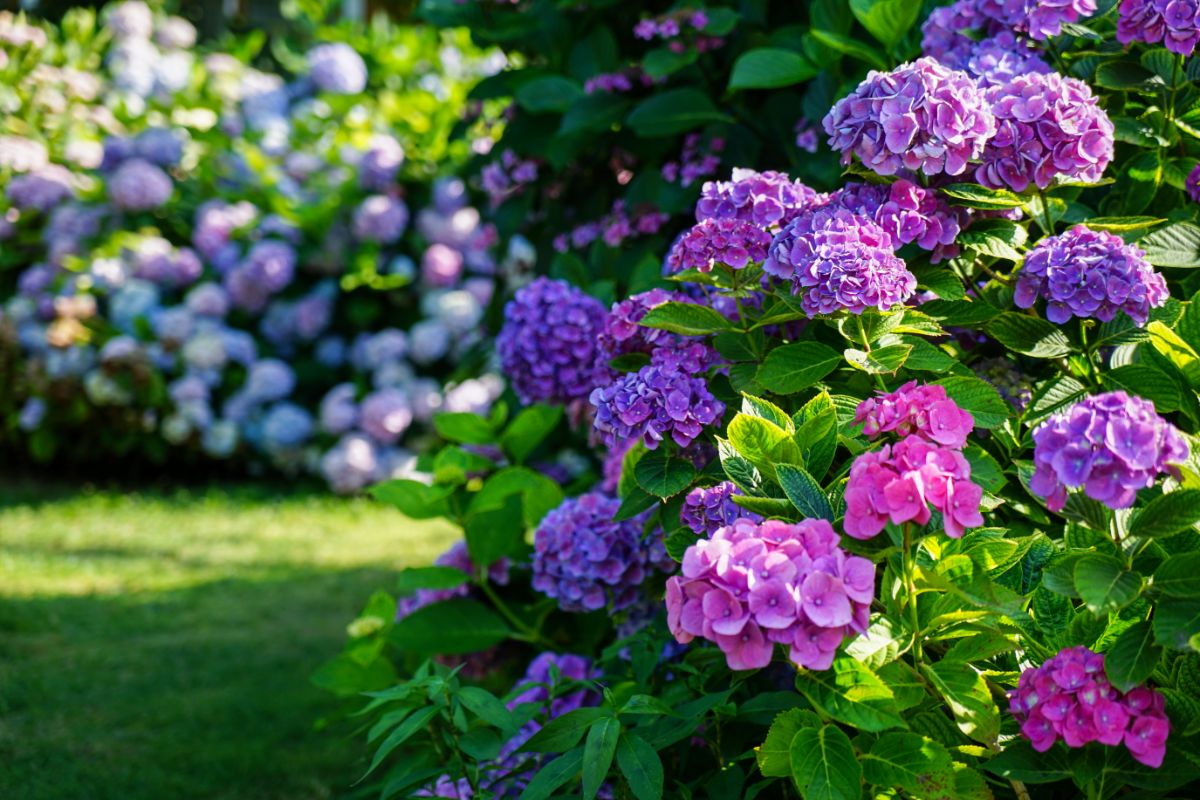
This guide will teach you how to grow these popular perennials in your garden. You can skip to the section you need in the table of contents below, or read on for the full guide to planting and maintaining hydrangeas.
What Are Hydrangeas?
Hydrangea is the name of a genus of plants that produce stunning balls of flowers.
Most of the plants in this genus are shrubs, but there are also climbers and trees. There are around 75 species in all and hundreds of cultivars.
Plants in the Hydrangea genus go by two common names. One, of course, is “hydrangea.” The other is “hortensia.”
Jump to:
- What Are Hydrangeas?
- Hydrangea Basics
- Where Do Hydrangeas Grow?
- Why Grow Hydrangeas?
- Hydrangea Landscaping Ideas
- Recommended Hydrangea Varieties
- When Do Hydrangeas Bloom?
- How Long Do Hydrangeas Bloom?
- When to Plant Hydrangeas
- Ideal Growing Conditions for Hydrangeas
- How to Plant Hydrangeas
- How to Care for Hydrangeas
- How to Divide and Transplant Hydrangeas
- Are Hydrangeas Vulnerable to Diseases or Pests?
- Recommended Planting Combinations for Hydrangeas
- Frequently Asked Questions About Growing Hydrangeas
- Where to Buy Hydrangeas
Hydrangea Basics
| Zones: | 3-9 |
| Blooming season: | Summer and fall |
| Expected height: | Up to 6 feet |
| Soil: | Rich and loamy |
| Sun: | Full sun, partial sun, shade |
Where Do Hydrangeas Grow?
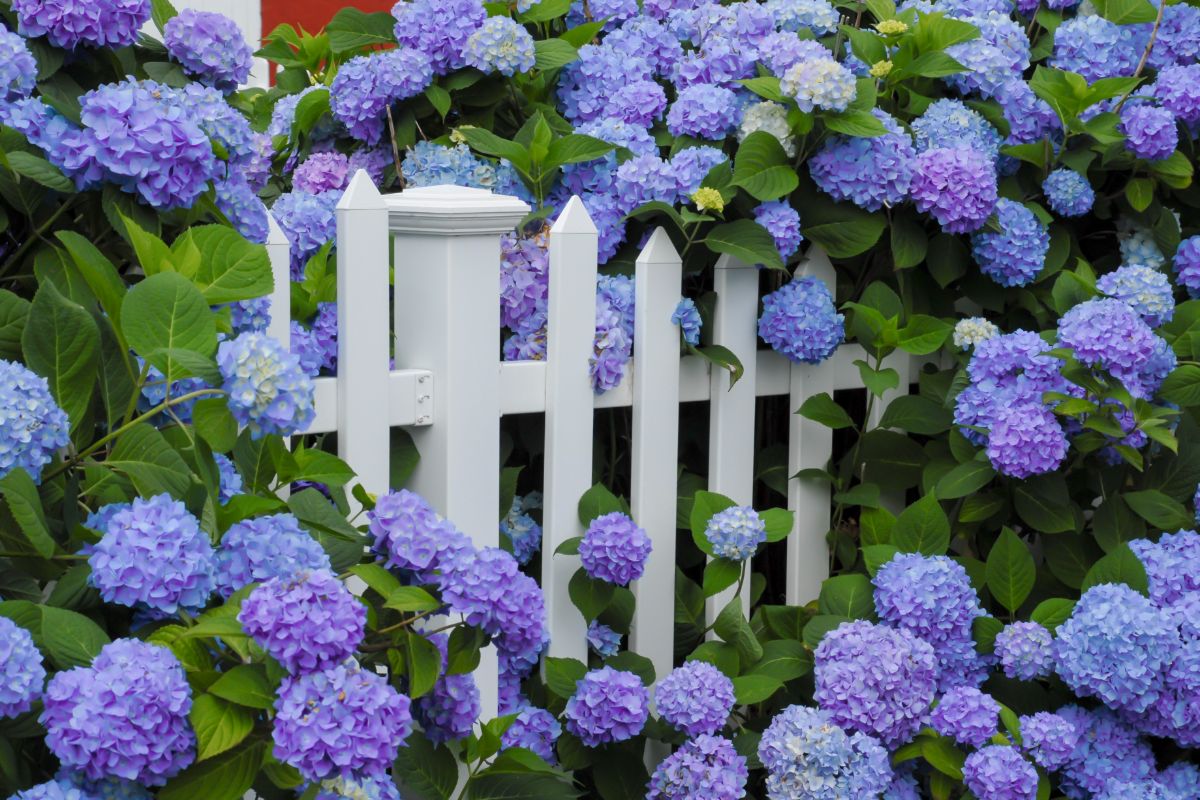
You can find hydrangeas growing throughout climate zones 3-9. While they are cultivated widely around the globe, they are native to the Americas and Asia.
Why Grow Hydrangeas?
There are so many benefits to growing hydrangeas in your perennial garden. Here are a few:
- The globe-like clusters of flowers that grow on hydrangea shrubs stand out like nothing else. You will love their dramatic effect.
- You can actually influence the colors of your hydrangea plants just by shifting the pH of your soil! For anyone with an interest in chemistry, this can be a really fun experiment. Plus, it means you can have nuanced control over the hues of your blossoms; you can even change them from one year to the next. How cool is that?
- You can attract bees with some types of hydrangeas, though not all. Some options for your pollinator garden might include Hydrangea anomala petiolaris and Hydrangea mycrophylla.
- Hydrangeas can help define your landscape. You can, for example, grow them into neat hedges to create pathways around your yard or section off different areas of your garden.
- You can conceal unsightly fences or walls using hydrangeas very effectively.
- Increase privacy by growing some of the taller varieties of hydrangeas, screening away your yard from prying eyes.
- Grow hydrangeas regardless of whether your garden has full sun, partial shade, or full shade. There are cultivars ideal for each.
- Hydrangeas are low-maintenance plants that are easy to grow, even for beginners. In fact, they are especially effortless in the pruning department.
- Pests are not usually a big problem with hydrangeas.
Hydrangea Landscaping Ideas
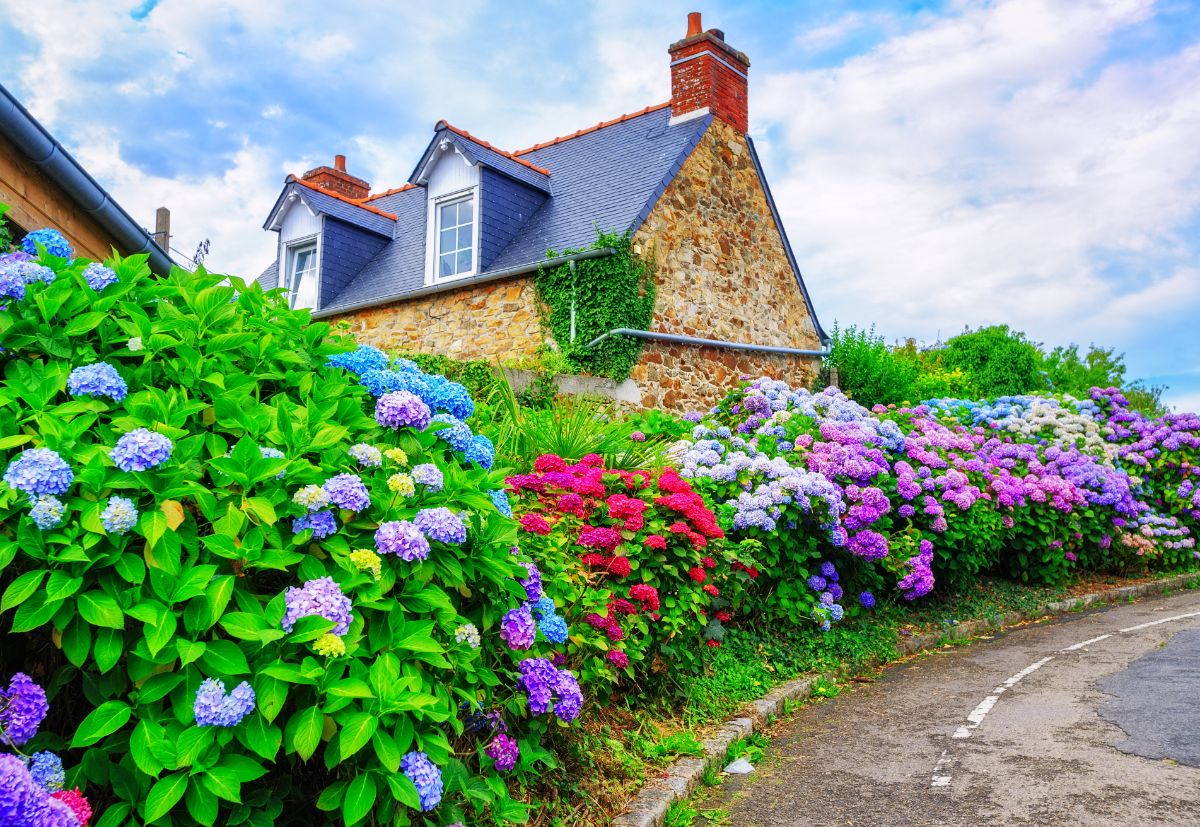
With their abundant blooms, there are so many ways you can use hydrangeas to enhance your garden:
- Line a walkway. The abundant blooms of hydrangeas are ideal for lining a pathway. In fact, you can plant them on either side of a walkway so that you are surrounded in colorful blooms as you walk through your garden.
- Grow hydrangeas along a fence. One of the most dramatic ways to use hydrangeas is to line a fence. You can plant regular hydrangea to form a hedge along the fence, or you can go with climbing hydrangea for a completely different look.
- Curb appeal. There is nothing quite like the eye-catching beautiful blooms of hydrangeas to really grab attention from the street. If you are going to be putting your home on the market anytime soon, some hydrangeas might help attract prospective buyers. Of course, you could also just plant them in front of your home so you can enjoy them as you pull into your driveway each day!
- Potted plants. If you want a fast and easy way to bring lots of color and life to a patio or deck, hydrangeas are a great option. You can grow them in pots or even hanging baskets.
- Surround a bench. Hydrangeas in spring can frame a garden bench beautifully, giving it a romantic look and feel. In fact, they can even increase the privacy of the bench.
Recommended Hydrangea Varieties
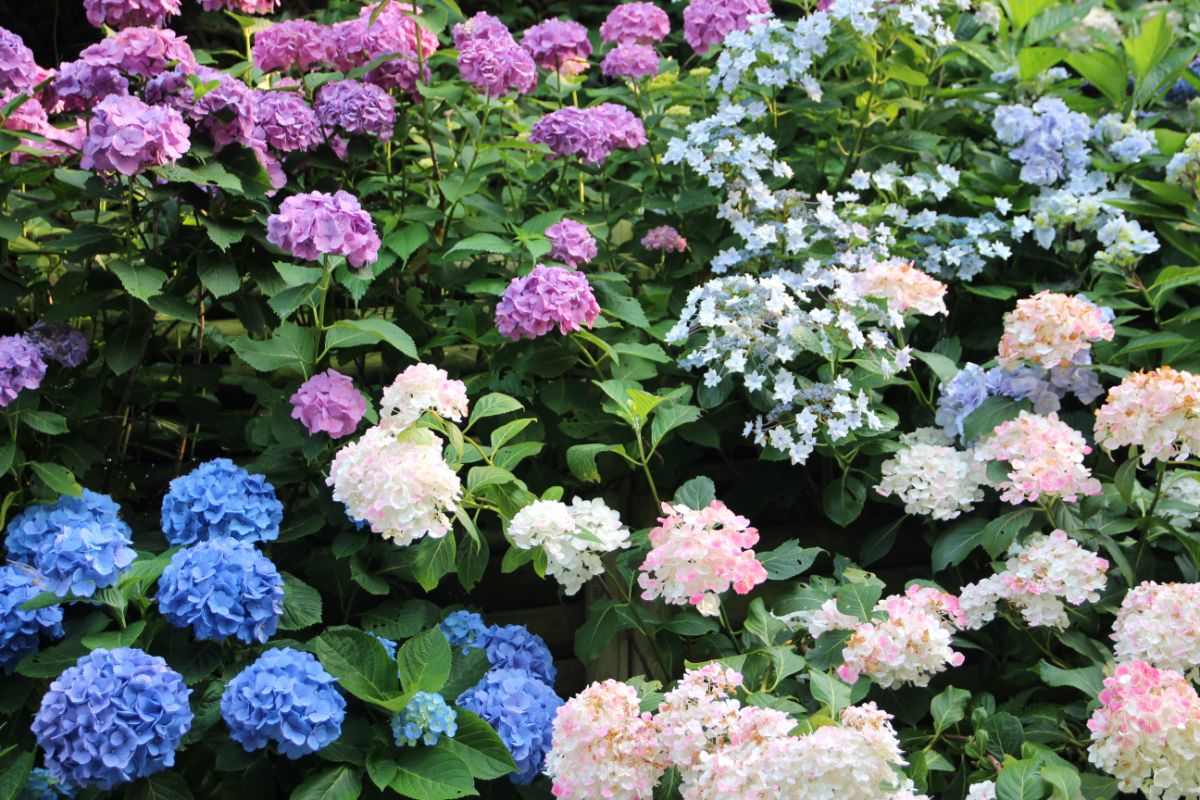
- Little Lime: This is one of the popular dwarf varieties that can work well in containers. The leaves are dark green, while the beautiful blooms have a pale green color, thus the name.
- Buttons 'N Bows 'Monrey' Hydrangea: If you are looking for a type of hydrangea with a really distinctive look, these pink flowers with their white rims will catch your attention. This cultivar does best in filtered sunlight.
- Let’s Dance ‘Big Easy’: Another option for pink blooms is the startlingly vivid “Let’s Dance ‘Big Easy’” cultivar. Initially, the flowers have a greenish hue. After they turn pink, they sometimes return to that original color.
- Nikko Blue: For blue hydrangeas, try this cultivar with its bold blue blooms.
- First Editions Vanilla Strawberry: For bright strawberry blooms that will steal the spotlight in your garden, consider this stunning cultivar. The flower heads have a frothy look with varying shades of dark and light pink topped with white. Also, with its height maxing out at around 6 feet, this cultivar is an excellent choice for a privacy screen. Another similar cultivar is the one named “Strawberry Sundae.”
- Double Down: This type of hydrangea features gorgeous double blooms. If you are looking for a wide bloom time, you will appreciate how these long-lasting flowers grace your garden from summer through fall.
- Tiny Tuff Stuff: The beautiful flowers produced by this cultivar of hydrangea have a delicate appearance. The color can be blue, pink, or white, depending on your soil.
- L.A. Dreamin’: The individual blooms of this unusual cultivar of hydrangea can be blue, pink, purple and green. Often, you will see a range of hues on every flower head. From a distance, there is an almost iridescent effect. This, of course, is an illusion, but it certainly makes these larger blooms stand out.
- Everlasting® Revolution: The compact size of this hydrangea is just one of the features that make it one of our favorite cultivars. We also appreciate its range if vibrant shades, with purples, pinks, blues, and greens often showing up on a single plant all at once.
- Quick Fire: If you want a hydrangea with fiery shades, you might like the popular Quick Fire with its warm hues. It is an early bloomer.
- Wedding Gown: For white flowers, try growing this elegant cultivar. You’ll be able to enjoy the blossoms in spring through autumn.
When Do Hydrangeas Bloom?
Most types of hydrangeas bloom in spring or summer. But you can find cultivars at blossom even into autumn.
How Long Do Hydrangeas Bloom?
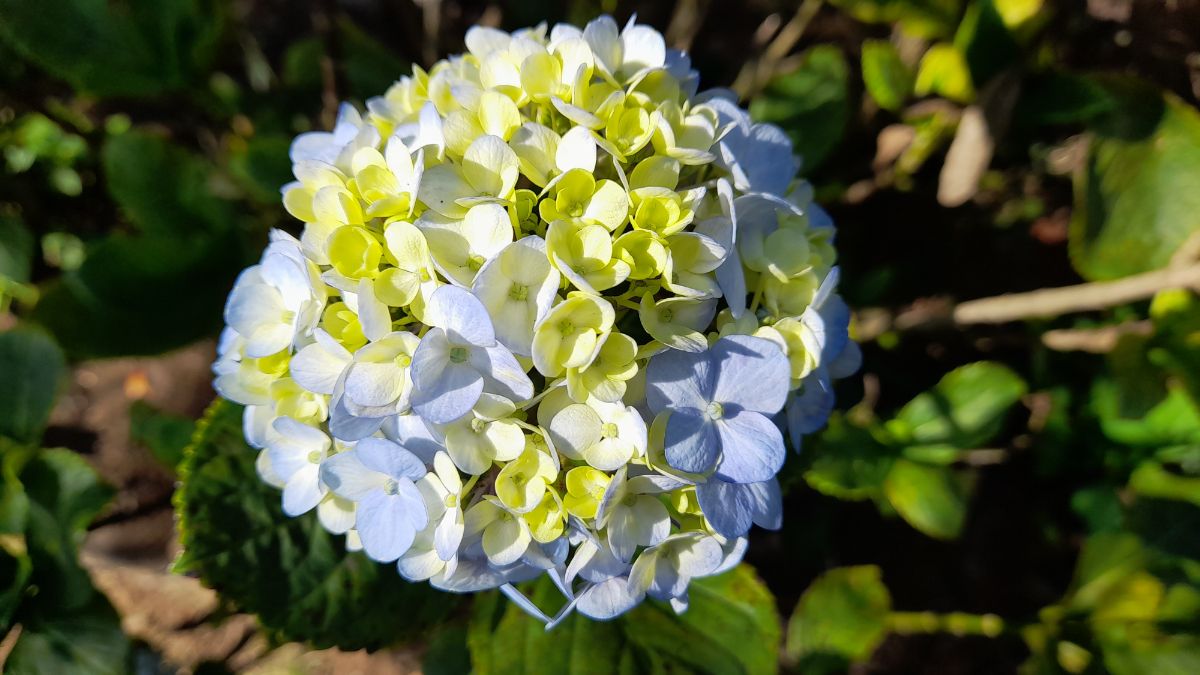
You can expect to enjoy hydrangea blossoms for a couple of weeks. If you have a variety that re-blooms later in the season, you may have months of blooms to look forward to each year.
You can also try planting cultivars that flower at different times to extend the bloom period for your hydrangea garden.
When to Plant Hydrangeas
If possible, you should aim for fall planting for hydrangeas. If you miss the autumn window of opportunity, you can try planting them in spring. These plants establish best if they are not subject to extreme high or low temperatures during the process.
Ideal Growing Conditions for Hydrangeas
To grow hydrangeas successfully, you need to know their requirements for sun, soil and water. Thankfully, you will discover that hydrangeas are not fussy.
How Much Sun Do Hydrangeas Need?
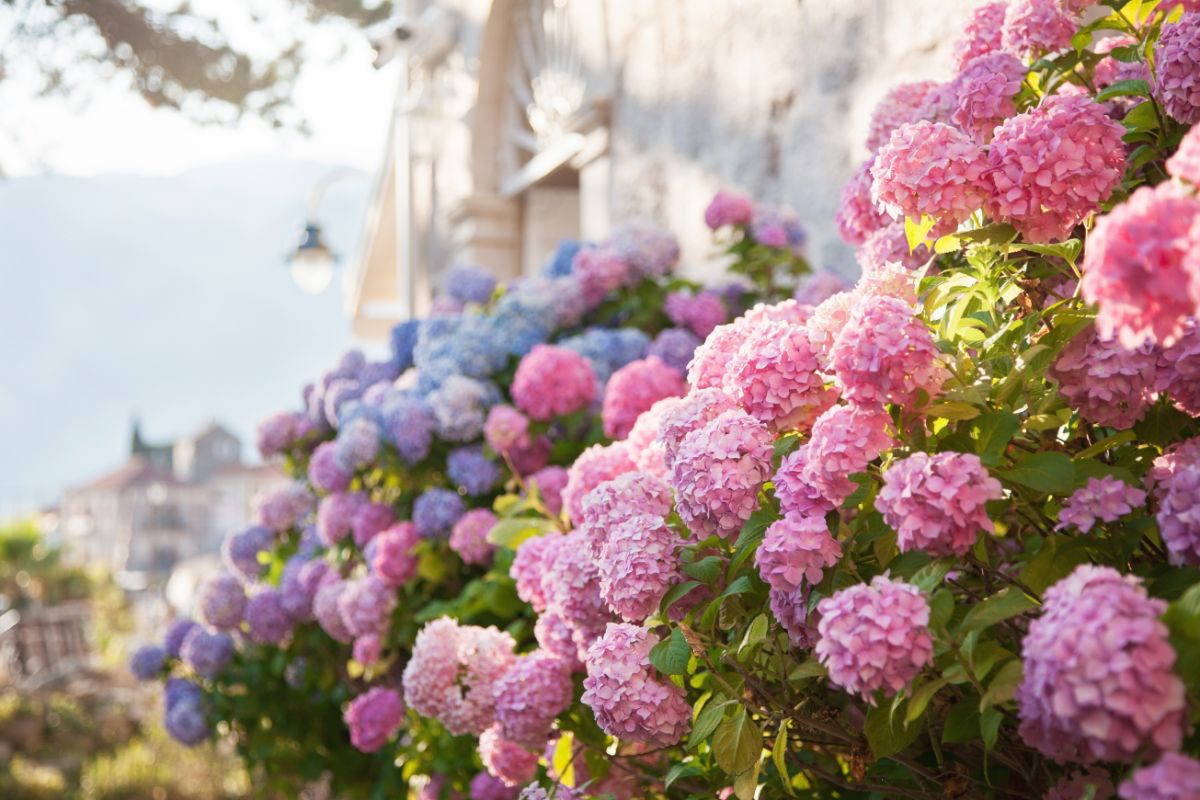
How many hours of sun your hydrangeas need depends on your location as well as the types of hydrangeas you have.
Around six hours of sun daily is ideal if you live in a northern latitude. If you live in a southern latitude, however, you may be able to get away with just three hours of daily sunlight.
You can grow hydrangeas in partial shade, full shade, or full sun. But you will discover some types thrive better in specific conditions than others.
Some examples of hydrangeas that grow well in shade include:
- Incrediball
- Invincibelle
- Annabelle
Some hydrangeas that prefer lots of sun include:
- Mystical Flame
- Little Quickfire
- Little Lime
When you are browsing hydrangea types, you should check how much sun is recommended. That way, you can choose hydrangea species that will be ideal for your garden.
What Type of Soil is Right for Hydrangeas?
The ideal garden soil for your hydrangeas is rich and loamy. You must keep the soil moist, but drainage is important. Nonetheless, they can grow in clay soils, especially if you loosen them up a bit with some compost.
Hydrangeas can grow in both acid and alkaline soils (see the FAQ for more information).
How Much Water Do Hydrangeas Need?
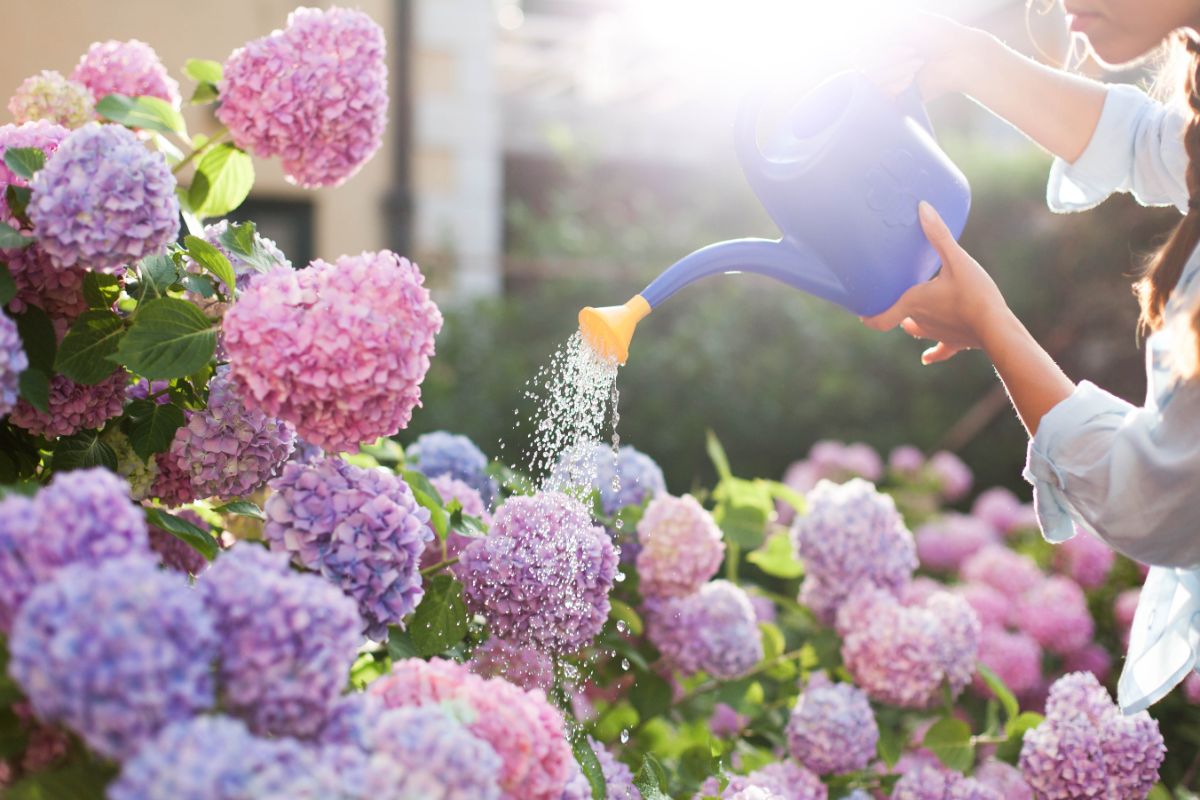
Water plants according to the instructions for the cultivars you planted. Instructions can vary, but around an inch of weekly water is typical for the growing season. Depending on your climate, precipitation may take care of some of this.
When you water your hydrangeas, do so close to the ground rather than allowing water to get on the leaves and flowers. You will be less likely to have problems with rot this way.
Hot afternoon sun can dry out hydrangeas, but you can help to prevent wilting if you give them water earlier in the day.
If you do see mid-afternoon wilting, however, that does not necessarily mean you should immediately engage in deep watering.
Maybe you are under-watering your plants, but you might already be giving them roughly the right amount of water. If you go overboard trying to water them now, you could actually end up drowning them. It is a common newbie mistake.
This post references Jan Becker of Harmony Hill Hydrangea Farm. The post explains, “Hydrangeas are amazingly resilient, she says. If they wilt in the heat of a summer afternoon, they will likely perk up by the next morning. But don't let them suffer too often or the cell structure will collapse and the leaves may not come back until fall rain or even next spring.”
So, what can you do if you must do something about the wilting? One suggestion is to use drip irrigation instead of deeply watering your hydrangeas.
Mulching can also go a long way, as can enriching the soil with organic materials.
If necessary, you could also consider transplanting the struggling hydrangeas to a new location. Maybe they just need some afternoon shade.
How to Plant Hydrangeas
Typically, you will grow hydrangea from a nursery plant. But you can also start the hydrangea from seed, or propagate it from cuttings.
Container Planting

You can get away with growing hydrangea in containers. Below are the instructions for starting hydrangeas in pots (we will assume you are using a nursery plant).
- Pick out a suitable container. Hydrangeas are big plants that require moisture in the soil, so you will need a hefty container with a diameter of at least 18 inches.
A container this size will provide plenty of space for your hydrangea. It also will not be as susceptible to drying out as a smaller container, which should help you keep your plant happy and healthy.
Add drainage holes to the container if it does not have them. You might also want to think about adding wheels, or getting a separate stand with wheels for the container. It might not be that heavy now, but once the pot is full of soil, you may be surprised how difficult it is to move and place.
- The next step in growing hydrangeas in containers is to fill each pot with rich potting soil.
- Make a hole for your hydrangea and plant it. Backfill the soil and tamp it down.
- Water deeply.
You will need to keep watering your hydrangea extra while it is establishing. And don’t forget—even larger pots can dry out more quickly than the ground. So over the long term, your potted hydrangeas may still need a drink more often than those in your garden beds.
Ground Planting
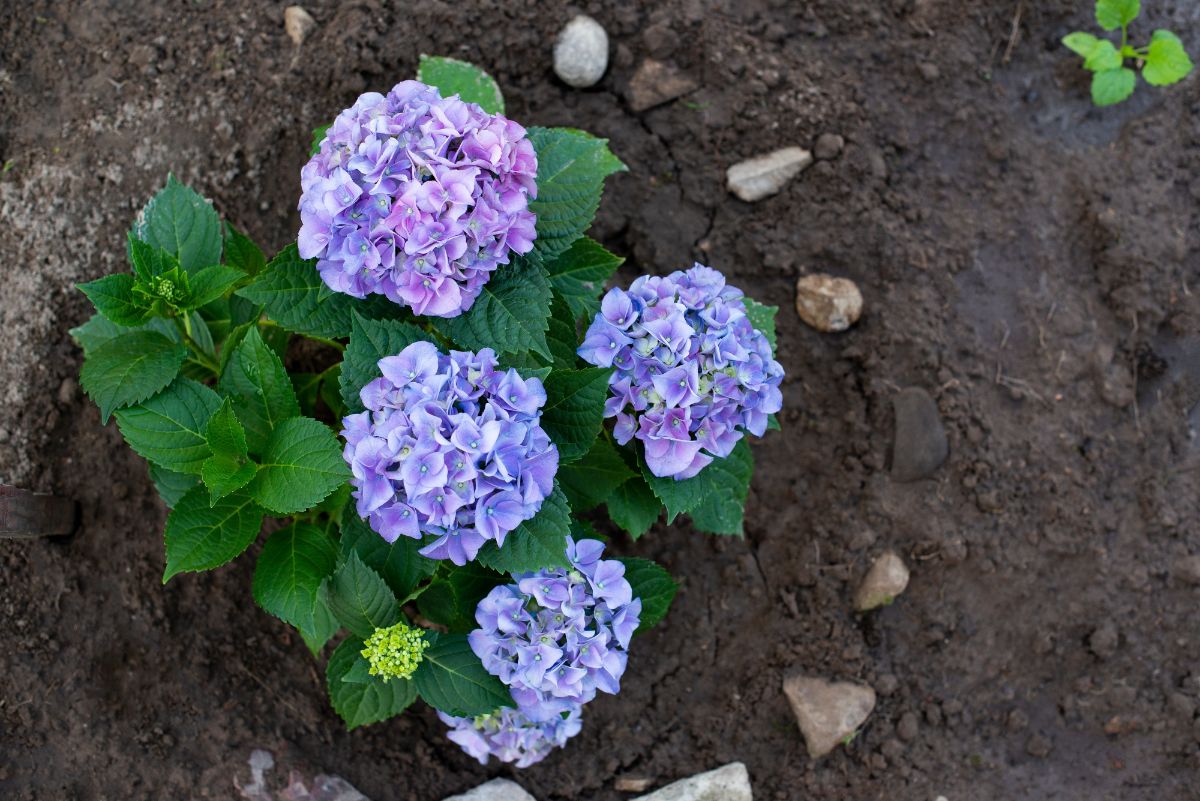
Planting your hydrangeas in the ground is similar to planting them in containers. Once again, we will assume you are using a nursery plant.
- Choose a suitable spot in your garden for the hydrangea.
- Prepare the soil. Hydrangeas love fertile soil, so mix in some compost. It also will help boost drainage.
You also may wish to modify the pH of your soil at this point to make it more alkaline or acidic. Changing the pH of your soil can change the resulting color of your hydrangea flowers (see the FAQ for full details)!
- Dig holes for the hydrangea nursery plants. They each need to be deep enough to accommodate the root balls and about double the width of each root ball.
- Plant the hydrangeas and backfill halfway.
- Water deeply. Wait for the water to go down into the soil.
- Now, backfill the remaining soil.
- Water deeply.
Give your hydrangeas some extra water as they are establishing. Then switch to your regular watering schedule.
Starting Hydrangeas from Seeds
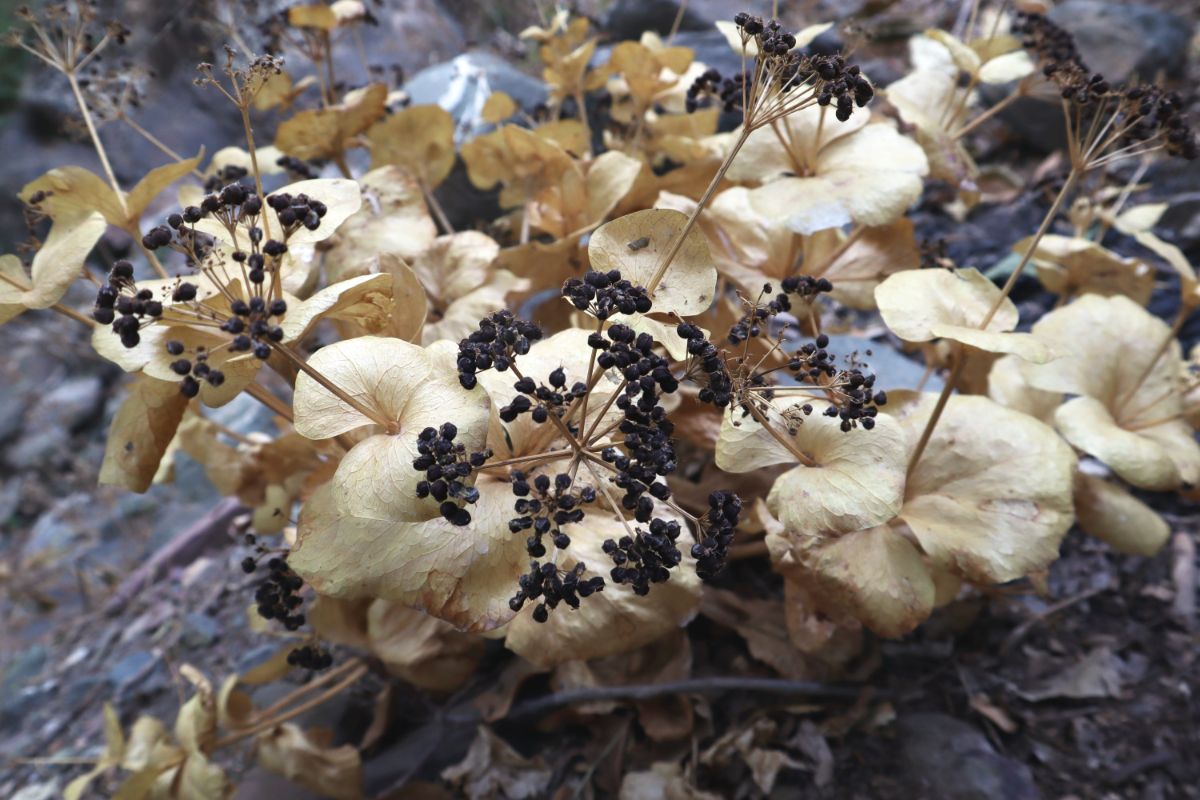
It is pretty easy to start hydrangeas from seeds! Follow these instructions:
- Harvest the seeds. The seeds are super small with a dust-like consistency, so the easiest way to harvest them is to tie a paper bag around a wilting flower head on an existing plant. Wait for the flower head to dry out. Then, shake it so that the seeds fall out into the bag.
If you will be waiting to sow the seeds, find somewhere to store them.
- Put soil in a container.
- Scatter the seeds on top of the soil. Do not cover them. They need sunlight to germinate.
- Find a spot inside your home where the seeds can germinate. A window with direct sunlight is ideal. If you do not have such a spot, you may need to use plant lights.
- Moisten the soil using a spray bottle. Do not pour water into the pot directly or the seeds will wash out.
- Continue tending to the soil and keeping it moist for 14 days. You should see the seeds germinate at the end of that period.
- Give the seedlings a little more time to grow, continuing to moisten the soil.
- When shoots form, harden the seedlings. This is a process of moving the seedlings outdoors for a few hours, then back indoors, then back outdoors for longer, and so on. After the seedlings spend more and more time outside, they will adapt to outdoor life.
- Plant the young hydrangeas in permanent containers or in your garden beds.
- Water the young hydrangeas extra as they establish outdoors.
Starting Hydrangeas from Cuttings
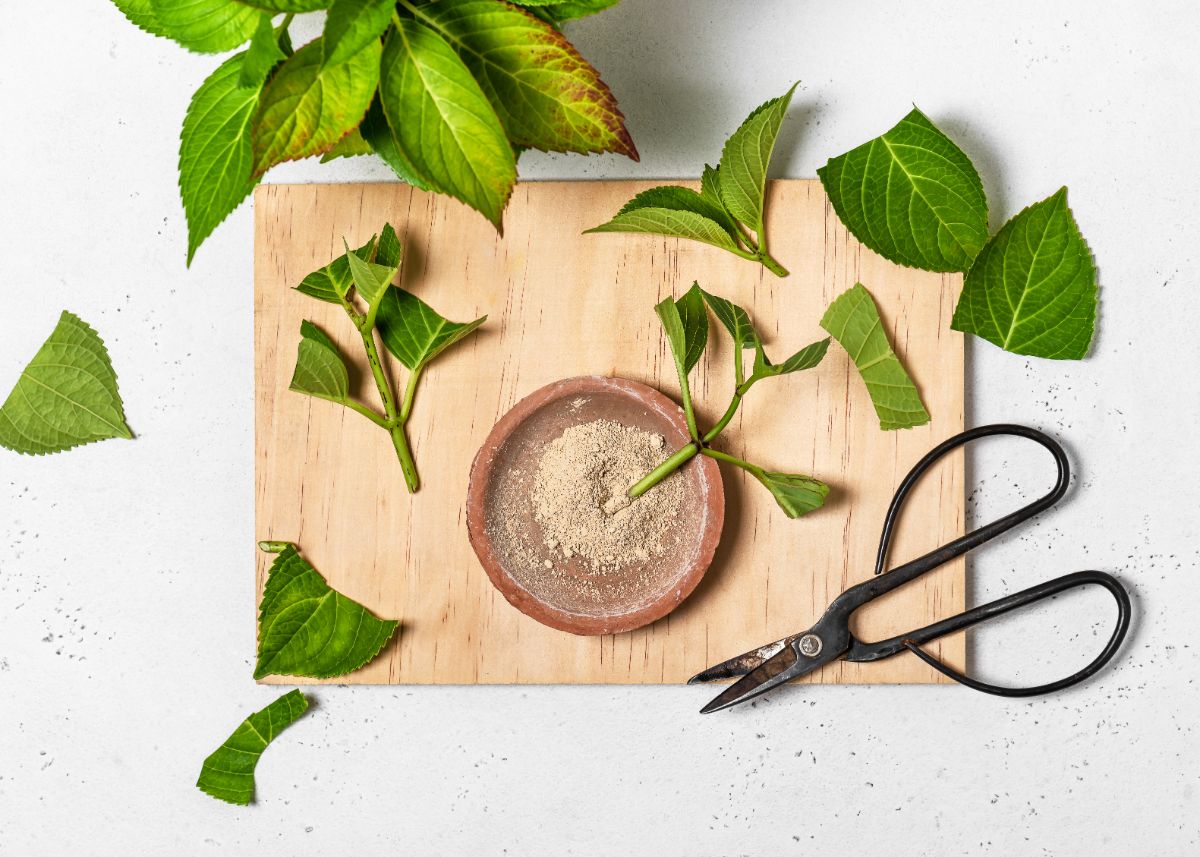
You will be delighted by how easy it is to propagate hydrangeas from cuttings.
- Take a cutting of new growth from an existing hydrangea. The cutting should measure around 4-5 inches, and should include several leaf pairs.
- Remove the leaves from the bottom part of the cutting. The top two pairs should be left alone.
- Dip the tip of the stem in rooting hormone. You may also want to apply anti-fungal powder.
- Fill a container with potting mix. Use a spray bottle to moisten it.
- Push the bottom tip of the cutting down into the soil. The leaves that are still on the cutting should be above the soil. The rest can be buried.
- Put a plastic bag over top of the cutting to lock in moisture. Are the leaves touching the sides of the bag? You will need to find a way to prevent this from happening. If necessary, you can trim the leaves a bit. Do not cut them off. But you can snip off half of each, and the cutting should do fine.
Why is it so important for the bag not to touch the plant? If there is contact between them, moisture on the side of the bag could cause hydrangea cuttings to rot.
- Find a warm spot for your cutting to root. It should not be in direct sun.
- Keep an eye on the cutting. Once the soil is dry on top, you can moisten it again. Keep doing this for several weeks. Eventually, the cutting will root.
- Once the cutting has rooted, you can continue to moisten the soil and give it a little more time for the roots to keep developing.
- Harden the new plant.
- Plant the new hydrangea in its permanent home.
How to Care for Hydrangeas
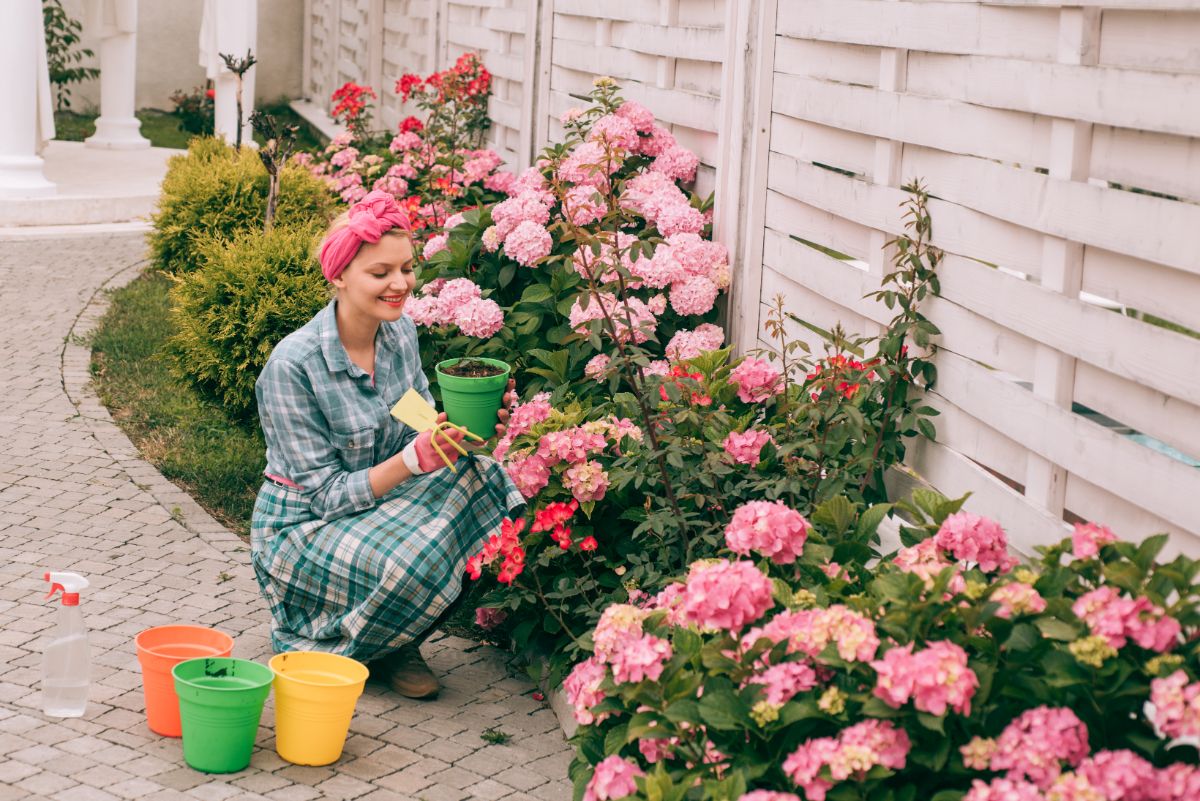
Now that you know how to plant hydrangeas, you need to know how to maintain them. Let’s go over the directions for fertilizing, mulching, pruning and staking.
How to Fertilize Hydrangeas
It is a good idea to feed hydrangeas. Clemson Cooperative Extensions suggests, “Bigleaf hydrangea responds to several light applications of fertilizer during the growing season. A general-purpose fertilizer, such as 10-10-10 applied at a rate of 2 cups per 100 square feet in March, May, and July is suggested. It is not necessary to remove the mulch when fertilizing, but water soon after application to help dissolve the fertilizer and send it into the soil.”
How to Mulch Hydrangeas
That brings us around to talking about mulching hydrangeas. It is a good idea to apply compost, pine bark or straw, chopped leaves, or a similar type of organic mulch to these plants.
Making sure to avoid putting the mulch too close to the stems of the plants, layer it up to around 3-5 inches in depth. You can go deeper with thicker mulch materials. With finer materials, you should stay toward the lower end of that range.
How often do you need to mulch? You should check on it annually in spring. Chances are good you will need to add some more mulch at that time so that it remains at the depth you want.
How to Stake Hydrangeas
Hydrangeas do not always need staking. But sometimes they do, especially in climates where you get a lot of wind and rain. The bigger the flower heads are, the more likely they are to flop when they get heavy with rain.
Even in those situations, however, you may not need to stake the hydrangeas. Check first if it is possible to simply pick up the flopped stems and kind of rearrange them so they are supporting one another. That may be all you have to do.
If you find yourself having to do this more often than you like or if it just does not cut it, you can try staking the hydrangeas.
Drive some stakes into the soil at a depth of around 4-6 inches. You can use bamboo stakes or wooden dowels. Make sure not to strike the roots with the stakes.
Use twine to tie the stems to the stakes. One thing to note is that you should not crowd together the flower heads. If you do, you might reduce air circulation too much. Moisture may build up, especially if it rains again and the flower heads collect the water and hold it. You then could find yourself combating fungal disease.
How to Prune Hydrangeas

Hydrangeas are effortless in the pruning department! As the Hydrangea.com specialty store explains, “If you're wondering if you should prune … the best thing to do is not prune. No hydrangeas strictly need pruning.”
Hydrangeas are split into two categories: those that flower on old wood, and those that flower on new wood.
If you jump to our FAQ section, you can read about “old wood” and “new wood” hydrangeas in detail.
As explained in that section, you should avoid pruning hydrangeas that flower on old wood—or at least keep it very minimal.
While you can prune more liberally with “new wood” hydrangeas, you do not have to!
How to Deadhead Hydrangeas
Now, the advice above pertains specifically to cutting back hydrangeas. While cutting hydrangeas back is unnecessary, you may still want to deadhead them. That means removing the spent blooms.
There are several reasons to deadhead your hydrangeas:
- The wilted blooms do not look tidy. You can improve the appearance of your garden by getting rid of them.
- Deadheading the spent blooms will stop them from going to seed. The plant can then use its energy more productively.
- Some types of hydrangeas can bloom more than once in a season. If you remove the spent blooms, you can encourage new ones.
Deadheading hydrangeas is fast and easy. You just snip the stem between the top set of leaves and the flower head.
If you have a re-blooming variety, you will hopefully soon be rewarded with a new flush of blooms!
How to Divide and Transplant Hydrangeas
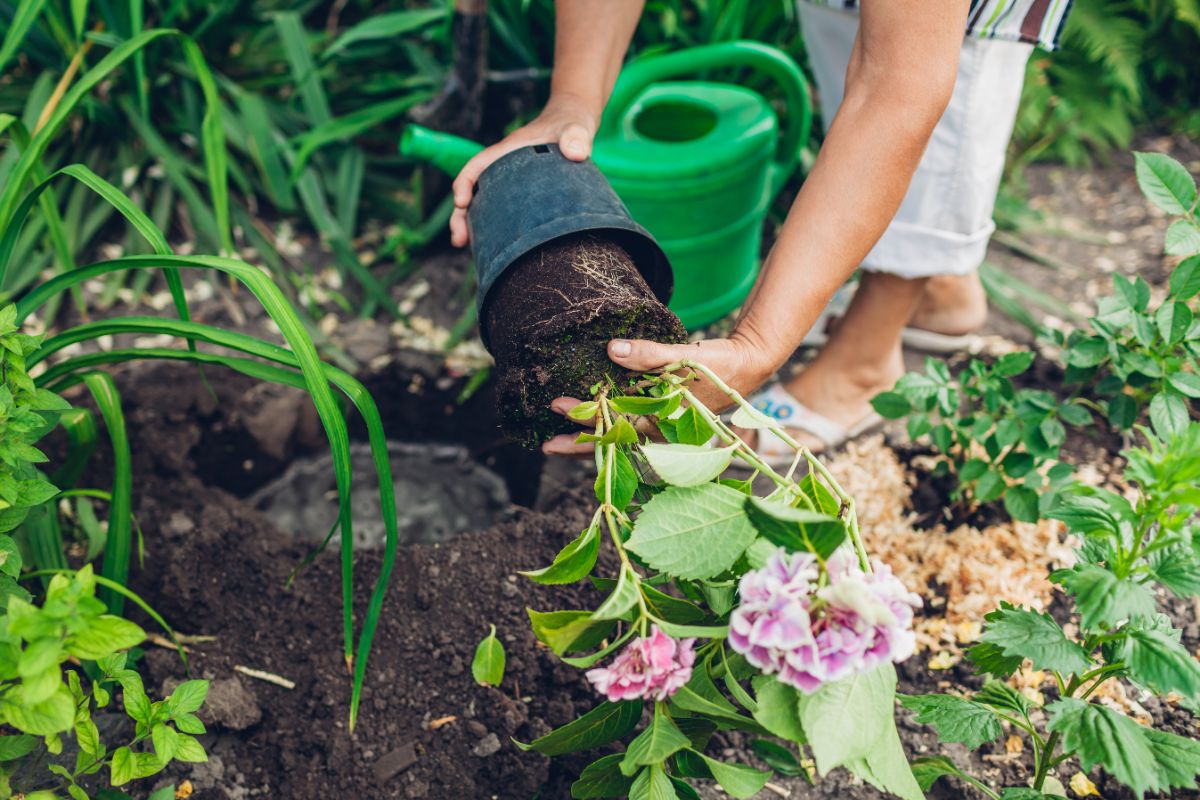
When it comes to dividing your hydrangeas, you have two options:
1-Dig up the entire root ball and split it.
Or …
2-Dig down and remove some of the shoots that you can find around the outside of the hydrangea.
Let’s go over how to do either of these.
To simply remove some of the shoots:
- Look for a young shoot on the hydrangea plant.
- Use a trowel to dig down in the dirt around the shoot.
- Once you have excavated the roots attached to the shoot, you can cut it off and pull it away from the main plant. You do not need to dig up the whole plant to do this.
- Fill the soil back in around the original plant.
- Transplant your new, small hydrangea.
The benefit of taking this approach to dividing is that it is not too laborious. It also may stress out the original plant less than pulling it up entirely.
To divide the whole plant:
- Water the hydrangea the day before you will be dividing it.
- You can probably figure out more or less how you will divide the plant before you dig it up. Based on that, you can group together some of the stems, tying them off with twine.
- Use a shovel to dig down in a circle around the hydrangea plant. Make sure you are digging well clear of the roots. You will need to get between 12-18 inches down.
- Use your shovel to push under the root ball and lift upward, prying the hydrangea out of the ground.
If you are careful and you work hard at it, you might be able to do this without harming the roots. But in some cases, you may have to cut some of the more stubborn ones.
- Divide the hydrangea. If you look at the root ball, you may notice there are some “junctions.” You can use these as division points. You will have to cut in with your shovel. If the shovel is not doing the trick, you can try using an axe.
Now you should have two or more divisions to transplant.
- Transplant the divided hydrangeas. Remember to give them extra water while they establish in their new spots.
If your hydrangeas do not blossom following division, do not panic. This is normal. Your divided hydrangeas have work to do developing their roots, and may not have the energy to produce flowers. But the following season, you should once again see blooms.
Are Hydrangeas Vulnerable to Diseases or Pests?
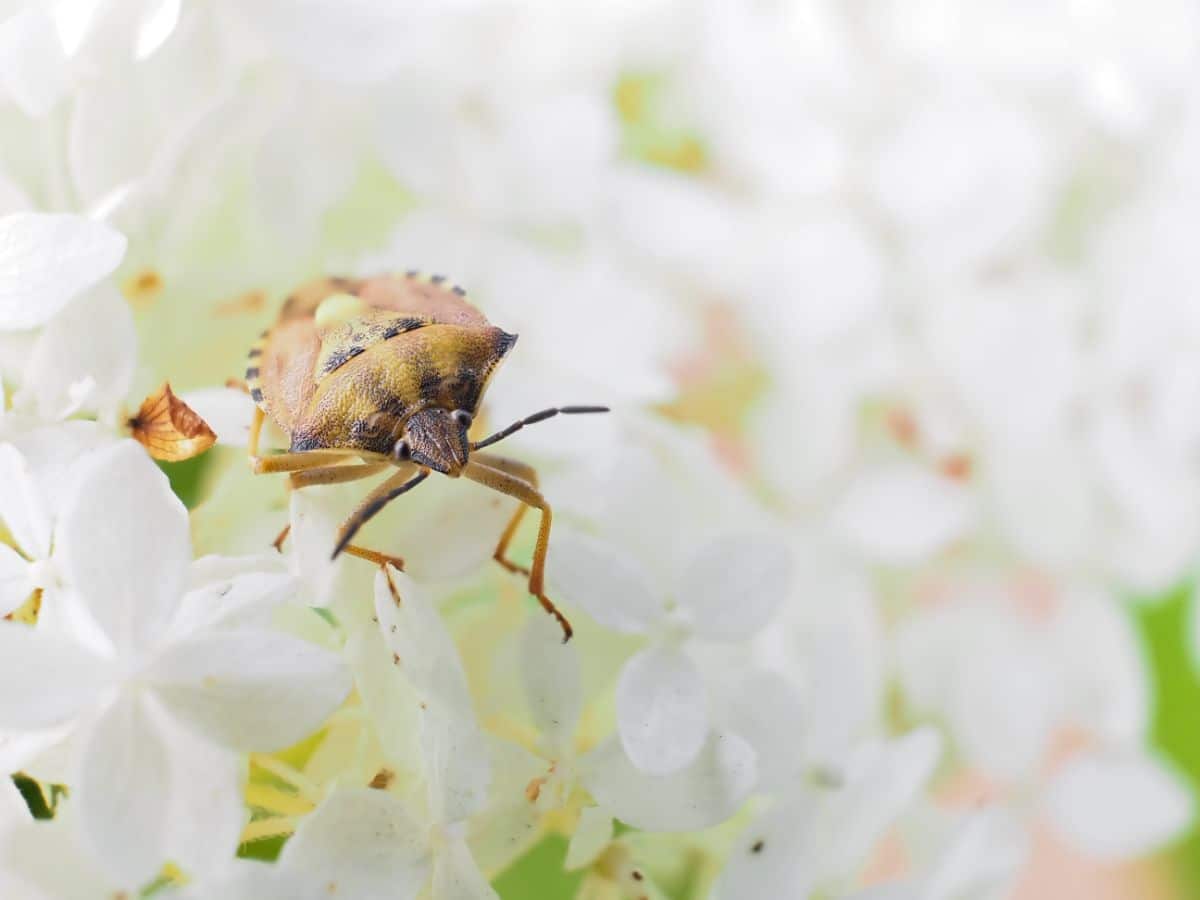
Diseases that can afflict hydrangeas include wilt, leaf spot, powdery mildew and blight, among others. You can find a list of diseases here as well as symptoms and management suggestions for each of them.
Remember, you can help prevent diseases by giving your hydrangeas adequate air circulation.
Usually, hydrangeas are pest-free. But if disease, recent transplanting, weather conditions, or other issues are stressing hydrangeas, pests may take hold.
Insects that can cause problems for hydrangeas include aphids, four-lined plant bugs, black vine weevils, two-spotted spider mites, hydrangea leaftiers, rose chafers and Japanese beetles.
University of Connecticut offers pretty extensive information about each of these pests on this page.
Along with insects, be mindful of slugs and snails, both of which may get into hydrangeas.
Alas, mammals sometimes will make a meal out of hydrangeas as well, for example deer and rabbits.
Recommended Planting Combinations for Hydrangeas
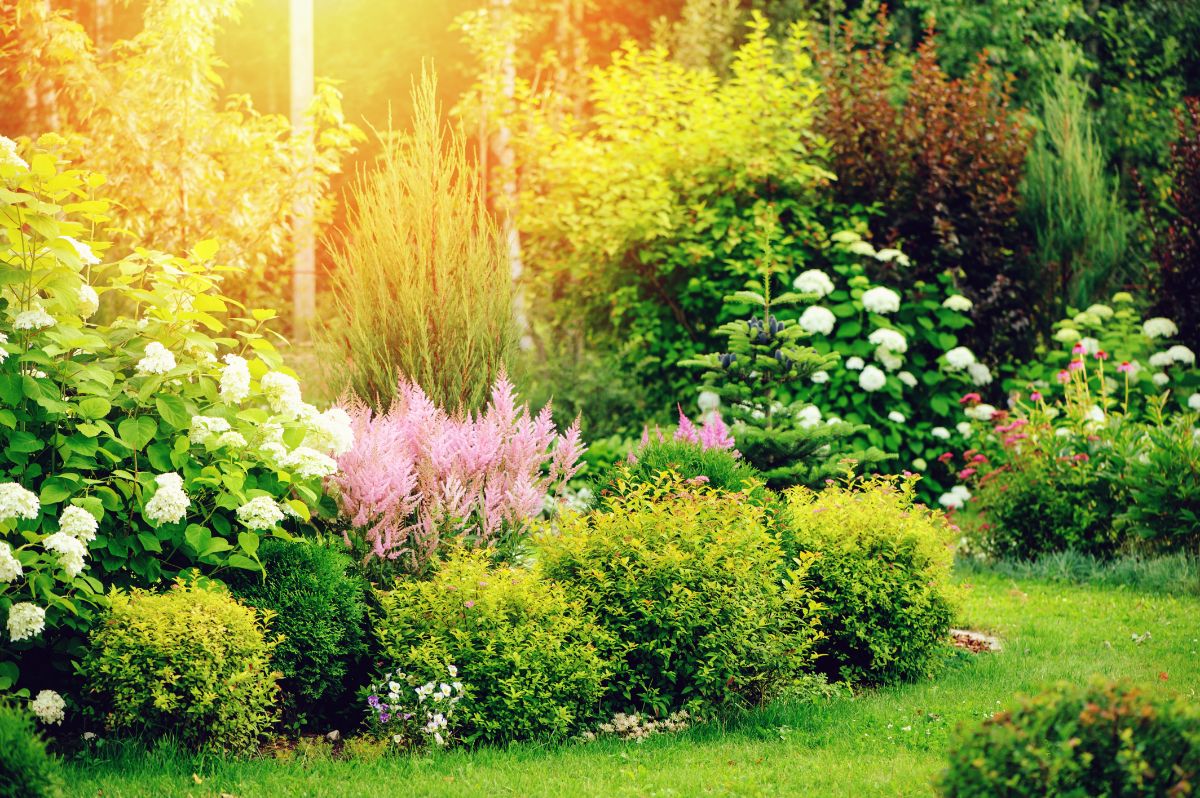
Here are a few ideas for companions for your hydrangeas:
- Ornamental grasses: Emphasize your hydrangeas by pairing them with a completely different texture. Any number of ornamental grasses can frame your hydrangea bushes well.
- Astible: Also called “false goat’s beard,” these flowers also bring textural contrast to your garden when planted alongside hydrangeas. They thrive in similar conditions as well, and should be quite happy planted next to each other.
- Coral bells: The dramatic, colorful foliage of coral bells can be beautiful next to hydrangeas.
- Dogwood: Since hydrangeas can grow in partial or full shade, you can consider a tree companion such as the flowering dogwood. The pink and white blossoms can really emphasize pink hydrangeas—or make a startling contrast to blue ones.
- Ferns: Like ornamental grasses, ferns can bring textural interest and contrast to your gardenia plot.
- Japanese maples: These lovely trees with their colorful leaves thrive in similar conditions as dogwood, and are another tree option for planting among your hydrangeas.
Frequently Asked Questions About Growing Hydrangeas
There are many possible explanations for what could be eating your hydrangea plants. It could be insects, slugs or snails, dear, rabbits, or other mammals.
You will see as you are shopping for hydrangeas that some cultivars are advertised as blooming on “new wood” or “old wood.”
A lot of sites take it for granted that you know what they are talking about, but many hydrangea newbies do not.
“New wood” refers to “new growth” on the hydrangea plant. If a hydrangea flower on “new wood,” that means buds form on fresh growth each spring. There are only buds for around three months each year.
By contrast, a hydrangea that flowers on “old wood” is producing buds on existing growth. Not only that, but it happens soon right after the previous blooms wilt. Instead of there being buds on the plant for three months of the year, they are present for around nine.
So, that means you cannot prune an “old wood” bloomer the same way you would a “new wood” bloomer.
But as this specialty store explains, “The solution, fortunately, is simple: just don't prune hydrangeas that bloom on old wood at all. It's okay to selectively remove a branch here or there or to prune out old wood, but you should never trim, shear, or cut them back. If you do, you won't harm the plant, but you will remove the flower buds for at least one year, and what's the fun in that?”
On the whole, hydrangeas need moist soil, and appreciate regular watering. But if you are in a drier area, you might consider planting an oakleaf hydrangea. You should do your best not to let it dry out, but it may weather drier times better than other types of hydrangeas.
One of the marvelous attributes of hydrangeas is to function as “living pH strips.” In fact, just by looking at the colors of the flowers on a hydrangea plant, you can make a determination about the pH of the soil.
The University of Georgia explains how this works in their CAES Newswire publication. The post says, “Color variation in hydrangeas is due to the presence or absence of aluminum compounds in the flowers. If aluminum is present, the color is blue. If it is present in small quantities, the color is variable between pink and blue. If aluminum is absent, the flowers are pink.”
What does this have to do with pH? The post continues, “Soil pH indirectly changes flower color by affecting the availability of aluminum in the soil. When the soil is acidic (pH 5.5 or lower), aluminum is more available to the roots, resulting in blue flowers.”
For more insights into the chemistry at play, take a look at a detailed article at American Scientist.
Here is roughly what you can expect in terms of colors based on the pH of your soil:
pH of 4.5: Blue
pH of 5.5: Cool purple
pH of 6.0: Warmer purple
pH of 6.8: Pink
pH of 7.0: Red
So, if you want to make your hydrangeas more bluish, then you need to make your soil more acidic. If you want to make them more reddish, you need to make your soil more alkaline.
Note that you do not always end up with a uniform color on a single hydrangea plant. In some scenarios, you might end up with a whole rainbow of hues on a single plant. Sometimes even individual globes of flowers will feature a gradient of hues.
It is also possible for your hydrangeas to be blue one year and pink the next, or vice versa, if the pH of your soil changes (whether deliberately or not).
How can you alter the pH of your soil?
There are a number of options for making soil more acidic. Perhaps the most common recommendation is to add sulphur. But compost can also make soil more acidic, as can certain types of mulch. Sphagnum peat, iron sulphate, aluminium sulphate, ammonium sulphate, and acidic fertilizer also make soils more acidic.
If your goal is to make your soil more alkaline, you can try adding lime or dolomite. Additional options for making soil more basic include bone meal, ground up shells, or wood ash.
The white blooms of white hydrangeas do not change color like some other types of hydrangeas. You can count on them to stay white.
There are a number of possible explanations for why your hydrangeas may not be producing blooms. The most likely culprit is injury over the winter.
But it could also be that they are not in an ideal location in your garden. They might not be receiving enough sunlight, or the soil might not be rich enough. If that is the case, adding compost and/or moving the hydrangeas might help.
Sometimes hydrangeas also fail to bloom if they are receiving excess nitrogen.
Hydrangeas are perennial plants. They bloom year after year.
Where to Buy Hydrangeas
If you are ready to bring the beautiful ball-shaped flower heads of hydrangeas to your garden, you can shop hydrangea cultivars online now.

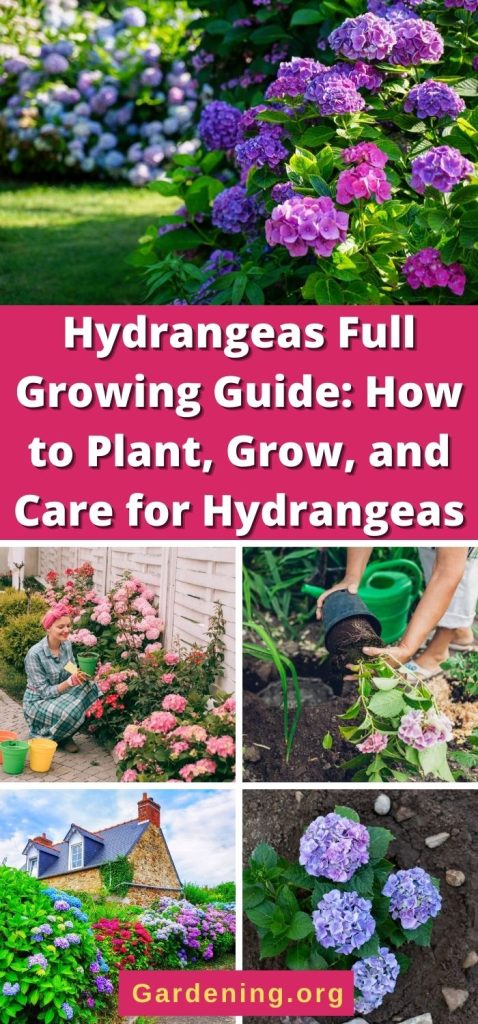
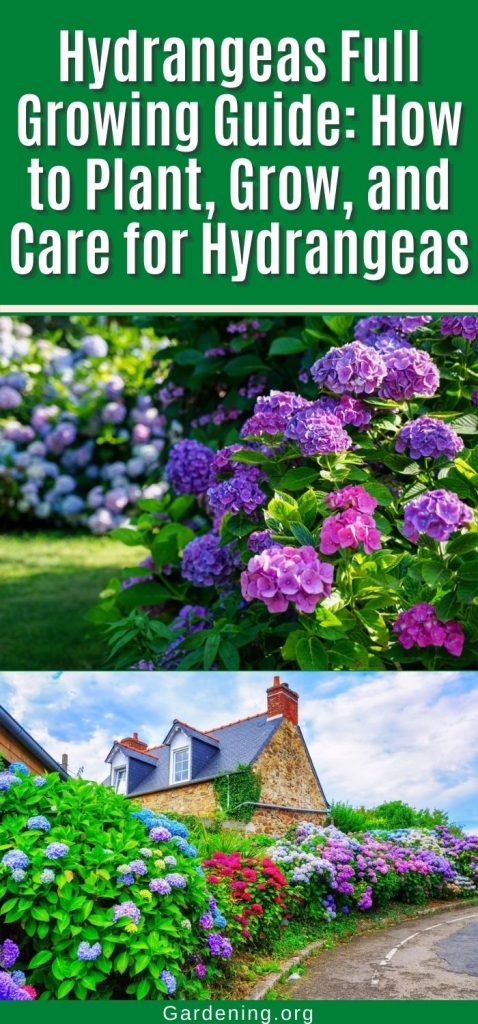
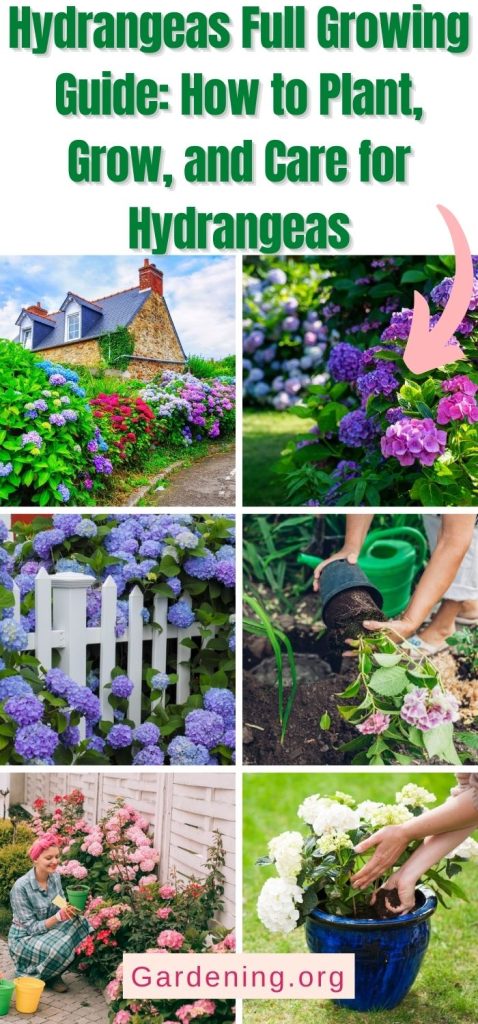
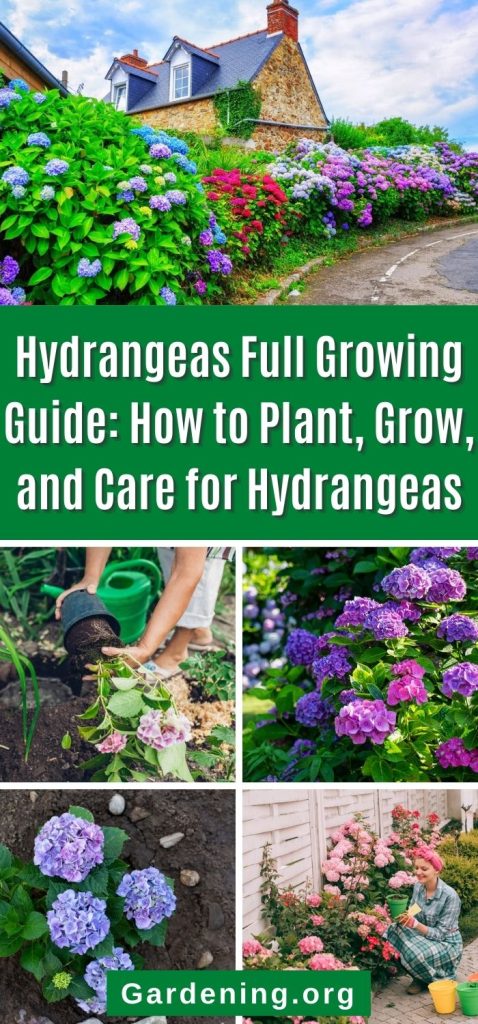

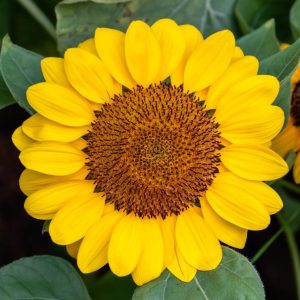
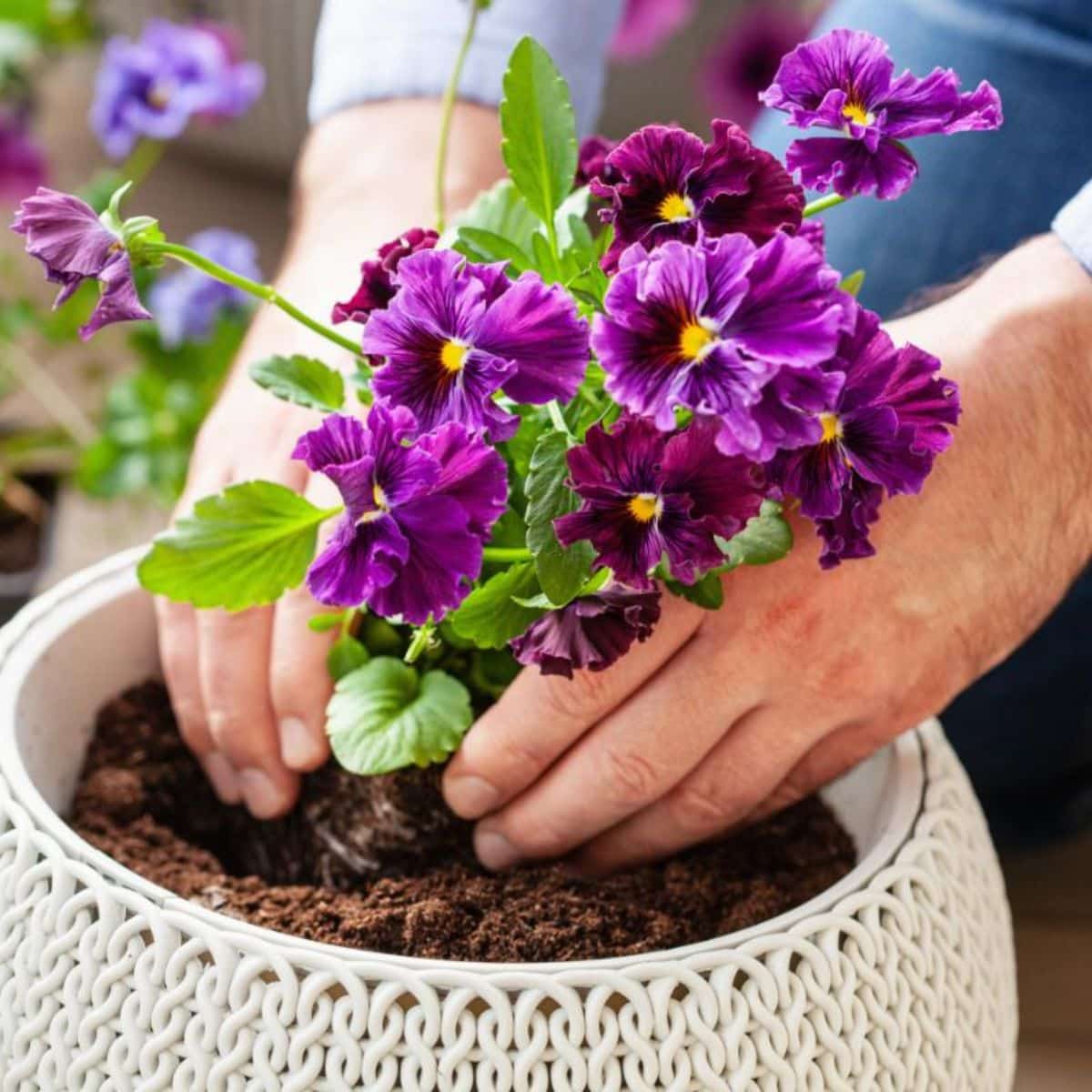
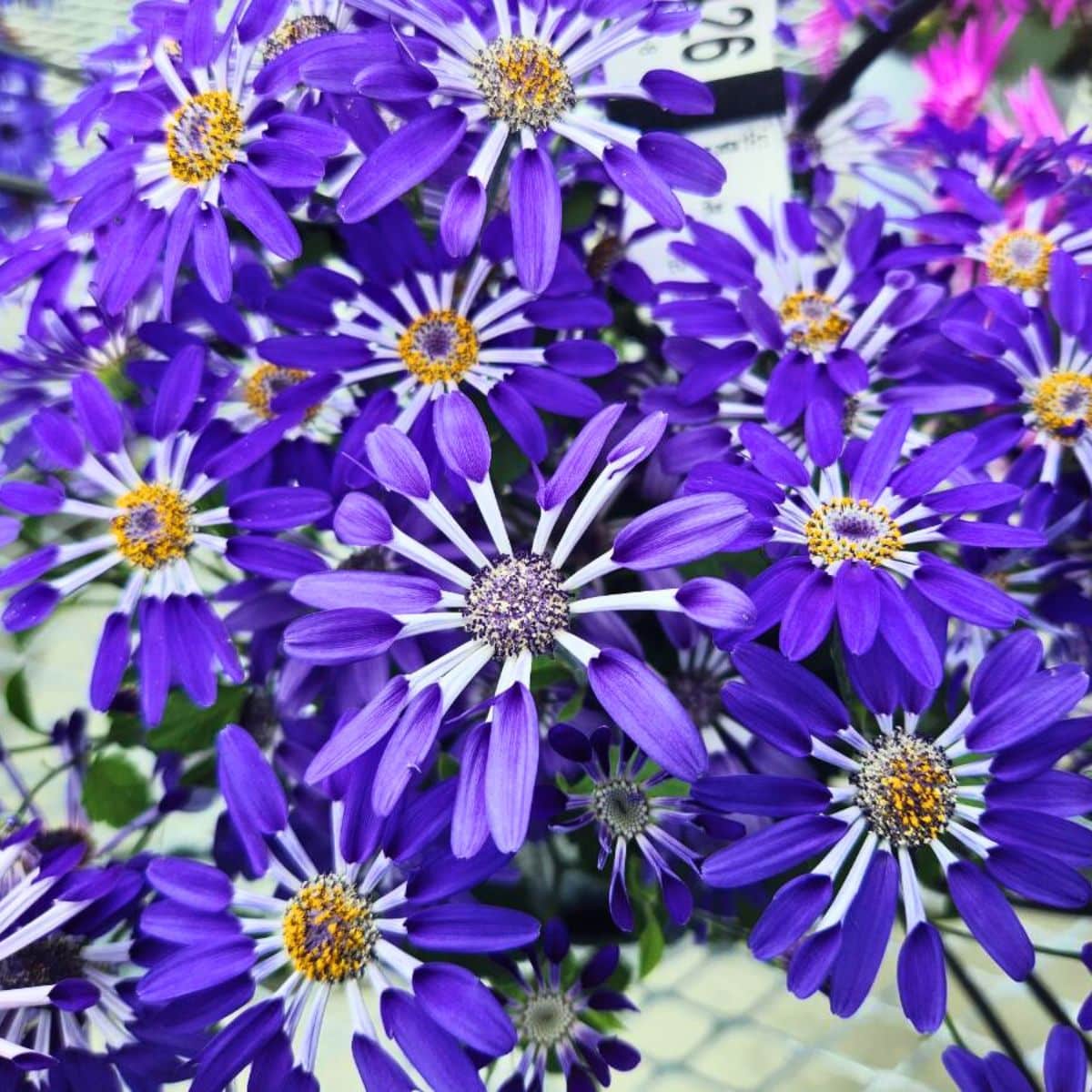
Vivion
I have a climbing hydrangea for at least 10 years. Lots of lovely leaves but has never bloomed. What can I do? I receives 6-8 hours sun each day and is in well drained soil
.
Julie Pruitt
I do not have a climbing hydrangea but mine is at least 10 years old and doesn’t bloom either. What can I do to make it bloom?
Mary Ward
Hi Julie. Please see the response on the climber comment. The same might be helpful to you. Good luck!
Mary Ward
There are several reasons why hydrangeas might not bloom, some more common than others. The most common reason is incorrect pruning--making the mistake of pruning off old wood on varieties that only flower on old wood (which is the most common). Sometimes late frosts can zap flower buds on some varieties or the buds can be experiencing winter kill to the buds. The more exposed the plant, the more likely this is to happen. If moving the plant is not reasonable, you might try wrapping it in burlap during the winter. If you know a late frost is on its way and you can cover the bush with row cover or a sheet, give that a try (I realize some of these are more difficult with the climbers, unfortunately). You may also be being a little too "nice" to it and overfeeding it, which will push more plant than flower growth. If you fertilize, try cutting back or skipping it for a year and see what happens. Also, and this is one people often don't even notice, deer love to nip off the buds without leaving notable damage to the rest of the plant. They're sneaky and like them young and tender, so you might not even notice that your plant ever had buds. Hope this is helpful--best luck!
Dawn Tenney
This is one of the most complete articles on Hydrangeas. I have Lace cap that bloom pink Lace cap is dainty flower and this the first very complete article I have read. I plan on adding more hydrangea plants to my garden. Thank you for your very helpful guide